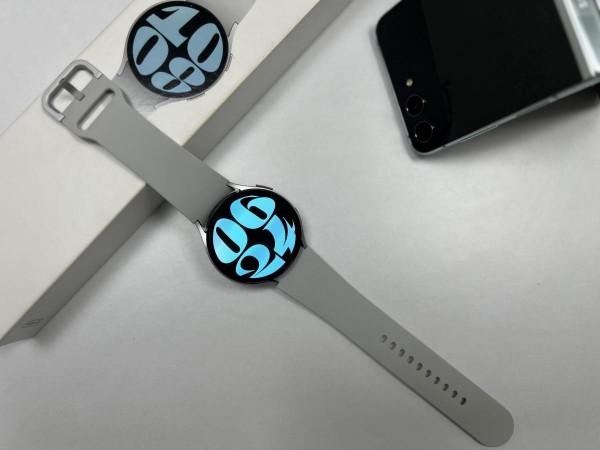Samsung Galaxy Watch6 review: Who needs a “crown”!
The world of wearables is divided into two: Android and iOS powered smartwatches. Within the Android ecosystem, there are watches focused heavily on health and fitness and then there are those that act as an extension of your smartphone on the wrist while also tracking good amount of activities and vitals. Samsung comes in the latter with its Galaxy Watch-series. Now, the Watch6 gives fitness fanatics something to ponder about.
Samsung Galaxy Watch6 was launched alongside the Watch6 Classic, a more premium offering which we’ve already reviewed. The Galaxy Watch6 is only slightly cheaper, achieved so by cutting some features while focusing on comfort, durability and efficiency.
Samsung Galaxy Watch6 comes in 40mm and 44mm options with or without LTE. Starting at Rs 29,999 for the 40mm Bluetooth variant, the LTE model costs Rs 4,000 extra. Similarly, the 44mm BT model is priced at Rs 32,999 and the LTE variant costs Rs 36,999. For comparison sake, the high-end Watch6 is the same price as the base-level Watch6 Classic. But the Watch6 directly competes against the new Apple Watch SE, which starts at Rs 29,900. So it’s got into a tough competition right there.

Note: Samsung sent us the 44mm Silver Watch6 model for review purposes. I’ve been using this watch for a week. The findings are based on that.
Samsung Galaxy Watch6: Key features
- Display: 1.5-inch Super AMOLED 432×432 pixel res.
- CPU: Exynos W930 1.4GHz dual-core chip
- RAM: 2GB
- Storage: 16GB (available 7.1GB)
- Battery:
- OS: WearOS 4.0 based Samsung OneUI 5.0 Watch
- Connectivity: 4G, NFC, Wi-Fi 802.11 a/b/g/n 2.4+5GHz, Bluetooth 5.3
- Sensors: Accelerometer, Barometer, Bioelectrical Impedance Analysis Sensor, Electrical Heart Sensor, Gyro Sensor, Geomagnetic Sensor, Infrared Temperature Sensor, Light Sensor, Optical Heart Rate Sensor
- Weight: 28.7 grams
Design
The Samsung Galaxy Watch6 boasts an incredibly lightweight design, tipping the scales at just 28.7 grams, a significant contrast to the Watch6 Classic’s 59 grams. This weight difference translates into a noticeable increase in comfort. While the design isn’t radically different from last year’s model, it prioritizes practicality, making it ideal for those who wear a smartwatch around the clock. The 44mm dial size fits comfortably on the wrist, and the soft silicone band feels gentle against the skin. No irritation issues here, and swapping bands is a breeze thanks to the one-click design.

The watch features two physical buttons on the right side, and they function as intended. They offer a satisfying click when pressed. A double press of the top button provides a shortcut to a user-selected function (I had it set to heart rate), while a single press serves as the home function. The lower button facilitates “back” function, but a long press activates Samsung Pay, allowing for wrist-based payments.

In terms of fit, the Watch6 offers superior comfort compared to the Watch6 Classic. The band connecting the dial hugs the wrist without leaving any noticeable gaps, resembling a traditional watch. However, the choice of band material makes the most significant difference. Achieving a similar level of comfort on the Watch6 Classic requires swapping the eco-leather band for a more flexible alternative.
The most significant design aspect is the display, which lacks the rotating crown found in the Watch6 Classic. While I missed this feature initially, the edge-to-edge look it provides, especially with dark watch faces, almost makes the bezels disappear. The Watch6 design may not be groundbreaking, but it marries design with practicality, a concept that I wholeheartedly endorse. Similar to the Classic, the Watch6 boasts an IP68 rating for dust and water resistance.
Display
The 1.5-inch Super AMOLED display on the Samsung Galaxy Watch6 is nothing short of fantastic. With a peak brightness of 2,000 nits, it’s a godsend for outdoor use, particularly on bright, sunny days. Navigating through the watch, swiping from the edges of the screen is smooth, and the display is highly responsive. What truly impressed me about the display is how Samsung cleverly activated the bezels for touch response. Swiping along the bezels allows for easy scrolling through the user interface, and the haptic touch response compensates for the absence of the rotating crown. At this point, I couldn’t help but think, “Who needs a crown?”

Health Tracking
The Samsung Galaxy Watch6 comes equipped with a comprehensive suite of health tracking features. While it doesn’t yet include ECG and BP monitoring in India (a feature missing even on the Watch6 Classic), it covers an impressive array of health metrics. These include 24/7 heart rate monitoring, tracking for over 90 different exercises, stress measurement, menstrual cycle tracking, SpO2 monitoring, and automatic workout detection for those prone to forgetfulness.

Sleep tracking, a valuable addition, functions seamlessly, much like on the Classic model. At this point, it’s challenging to pinpoint what the Watch6 can’t do compared to the Watch6 Classic. Samsung generously offers many health and tracking features free of charge, a noteworthy aspect of this smartwatch. While the Watch6 may not cater exclusively to athletes due to some inaccuracies in its BIA sensor, it serves as an excellent baseline marker for body composition analysis.

The Watch6 also incorporates skin temperature monitoring during sleep, a valuable feature for fitness enthusiasts. Moreover, the personalized heart rate zone is a must-not-miss feature for those who engage in regular workouts.

Performance and UI
Under the hood, the Samsung Galaxy Watch6 is powered by the Exynos W930 chipset, offering a slight improvement over the Watch5. While there are no major performance issues to report, as it capably handles day-to-day tasks, what truly stands out is the user interface and software optimization. Samsung’s collaboration with Wear OS 4.0 on the Samsung OneUI 5.0 Watch interface results in an intuitive and efficient user experience.

The Samsung Health app serves as the central hub for all health-related data, which is pivotal to the overall watch experience. Despite the small display, the full-sized QWERTY keyboard proves to be surprisingly usable, complete with predictive autocorrect. While not a daily necessity, it’s a welcome feature.

Battery
The battery life of the Samsung Galaxy Watch6 is commendable, offering a satisfying two-day lifespan under standard usage conditions. However, if you opt for the always-on display feature, you might not make it to the end of the second day. Fortunately, a quick charge can rejuvenate the watch between activities. For travelers, it’s advisable to disable the always-on display and adjust real-time vital monitoring to longer intervals to maximize battery life.

Paired with a Galaxy Z Flip5, the Watch6 lasted an average of two days before requiring a recharge. This usage included tracking one hour of activity, sleep monitoring, receiving daily notifications, and experimenting with various watch faces to match different outfits. While there are alternatives with longer battery life, the Watch6 offers a well-rounded package that meets the needs of many users.
Charging the watch, however, remains unchanged, utilizing a 10W charger that takes around 90 minutes to fully charge the device. Regrettably, the wireless Qi charging feature is absent, limiting its compatibility with other Samsung devices.
Verdict
In conclusion, the Samsung Galaxy Watch6 delivers everything you’d find in the Watch6 Classic, except for the rotating crown. However, the clever haptic touch bezel compensates for its absence in a subtle yet effective manner. If you’re willing to forgo the aesthetic appeal, the Watch6 proves to be remarkably comfortable, suitable even for nighttime wear. Its fantastic display, robust health tracking capabilities, reliable battery life, and decent performance make it a compelling choice.

In fact, I’d go as far as recommending the Watch6 over its premium sibling and even the Google Pixel Watch. However, it’s essential to recognize that while the Watch6 excels in its territory, it doesn’t stand unopposed in the presence of the Apple Watch. The two serve different markets, and there’s no confusion in that regard.
